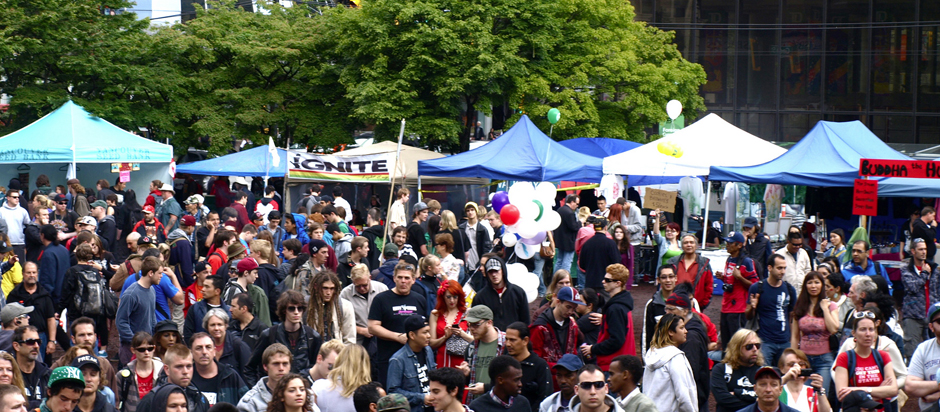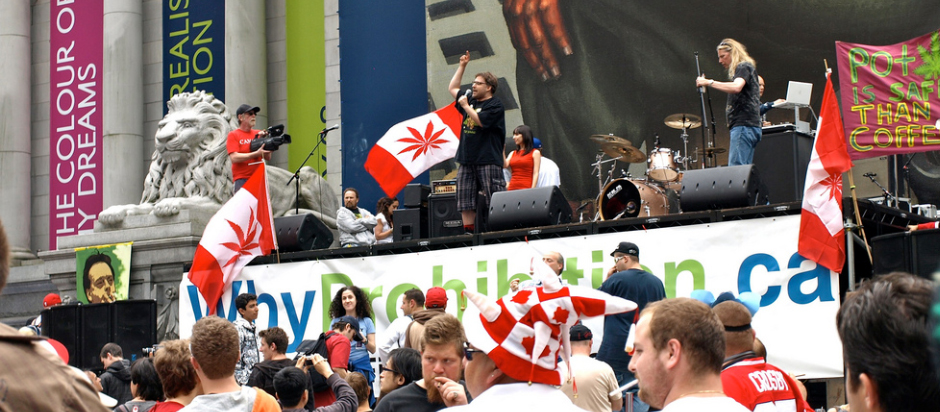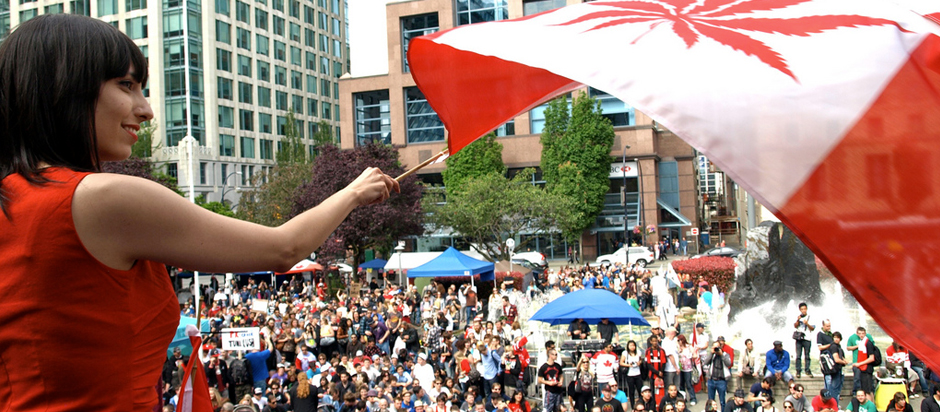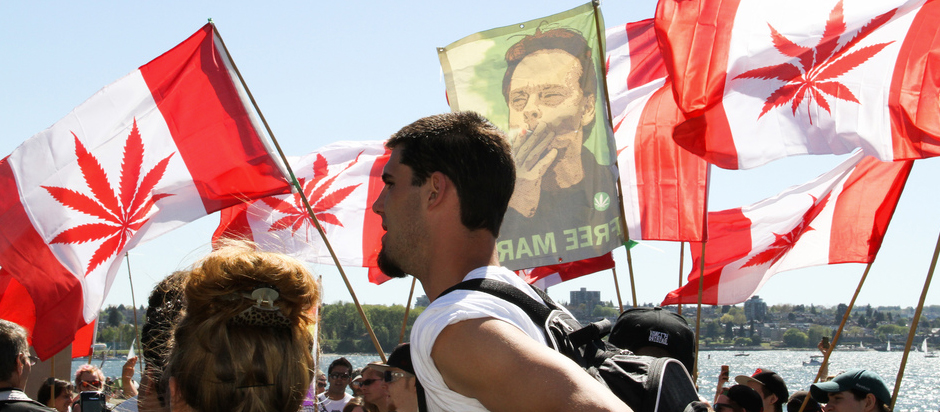
by David Malmo-Levine, Cannabis Culture
Cannabis Day has grown from a small gathering of enthusiastic potheads in the 1970s into a full-fledged marijuana festival and open Cannabis Farmers Market. CC presents a detailed history of Canada’s annual cannabis celebration/birthday party.
“It was tokin’ time Sunday afternoon. Despite heavy police scrutiny, about 2,000 people turned out at the provincial legislature grounds for one of the biggest marijuana legalization rallies ever staged in Alberta. The ‘smoke-in’ was intended to give city marijuana users a chance to ‘toke’ together in defiance of current marijuana laws, which organizers claim convicted 35,000 Canadians last year. While a few people did light up, the majority chose not to deliberately test the 60 policemen, many of them in plain clothes, mingling in the crowd.”
“Some tokin’ jokin’, little provokin'” Edmonton Journal, July 3, 1978
Here I was thinking I had invented Cannabis Day. It’s true that I came up with the idea of having a pot rally on July 1st, back in 1994 – on Canada Day – with “Grassroots”, the Edmonton-based cannabis legalization organization I belonged to. We called it “Cannabis Day” on our posters.
As it turns out, members of the Alberta Legalization of Cannabis Committee and the Canadian Association to Liberate Marijuana had come up with the same idea back in 1977.
The Late ’70s
Well, maybe not exactly the same idea. Their “smoke-ins” involved a policy of refusing to encourage or discourage cannabis smoking. Our smoke-ins not only encouraged pot smoking, but we pledged to non-violently but assertively resist any attempts at arrest as well. More about that “hug power” stuff later.
As much as I’d love to take credit for coming up with the whole idea myself, the people who came up with the idea of turning Canada’s national holiday into Cannabis Day were those Edmonton pot activists of the 1970s.
Vancouver artist and drug-peace activist Dave Douglas recounts his experience at the very first Cannabis Day in Edmonton back in 1977:
Myself and several other friends who had come to Edmonton for school the following September heard about a pot rally and a possible smoke-in at Klondike park, the exhibition grounds where the fair is held every year. We were hesitant at first, not wanting to get busted, but it turned out to be a really nice sunny day, so we went.
There was a small stage set-up in the front grassed area of the park close to the road near 118th as well as a couple of tables. About 100 or so people showed up for the afternoon and folks sat around in the grass and smoked some weed.
One of the tables had the author of Grow Your Own Stone selling his book and encouraging folks to fill out the form on the back and send it to Ottawa demanding pot be legalized. Speakers from NORML and other supporters gave heartwarming speeches. Cops just stood around near the parking lot by the race track or near the road but didn’t arrest anyone we saw that day.
Very close to the end of the event I remember people showing up to bet on the horse races and jeering at us to “grow up” and telling the cops “You should arrest these losers” but other than that it went pretty well. I bought a copy of Grow Your Own Stone, a bag of some awesome buds, and joined NORML.”
It was even called Cannabis Day before there was really a Canada Day! Up until 1982 the actual national holiday was called “Dominion Day”, but the July 3, 1979 Edmonton Journal showed a picture of a protester holding a sign with a pot leaf and the words “LEGALIZE IT”, with a caption that read;
Grass-roots stance – A happy protester shows his Sunday preference ‚Äì Dominion Day for most Edmontonians, but cannabis day for his compatriots. The Alberta Legalization of Cannabis Committee and supporters made their third annual appearance at the legislature at “high noon.” The event attracted 2,000 people last year, but only 250 participated this time. The protest Sunday was the final event of a three-day weekend sponsored by the ALCC and the Canadian Association to Liberate Marijuana.
That was 1979. Then Nancy Reagan and her “Just Say No” rhetoric came into power in North America the following year and the pot activists on both sides of the border got quieter – for a while.
1993
I had been introduced to cannabis in 1985. I was 14 years old. I’d never been to – or even heard of – the smoke-ins of the 1970’s that went on in Edmonton. I’d read some Harold Hedd comic books that mentioned the Grasstown Riot, but that was about it until in 1992 when I traveled to Telegraph Avenue in Berkeley, California and bought the Yippie publication “Blacklisted News” – complete with the chapter on “How to do a smoke-in”. Smoke-ins had already started up in Vancouver by then and a group that I helped form called “Grassroots” and I were planning one for July 17, 1993.
But there was one problem with the Yippie method. Their advice for dealing with the cops was something like, “we aren’t the type of people to tell others not to defend themselves” and “we are ready to throw bricks if we need to.”
I, on the other hand, was a non-violent activist. I wasn’t about to throw a brick at any police officer. But I didn’t want to stand around and do nothing if the police were going to arrest people for smoking pot.
I’d just watched a documentary called Berkeley in the ’60s that included footage of students resisting arrest non-violently – hanging on to each other while the cops attempted to drag them away – during sit-ins of hotels with racist hiring practices.
 I thought, “why not do the same thing at the smoke-ins? Why not resist non-violently?”
I thought, “why not do the same thing at the smoke-ins? Why not resist non-violently?”
The Rodney King incident – where cops were caught on film using force without justification – was fresh in peoples’ minds, and the police were reluctant to be caught looking like the bad guys on video. Prices of video cameras were dropping, allowing regular people to record everything. I knew at least one person would have a video or film camera with them during this event. Hug power was born.
See the clip from Berkeley in the ’60s (in my High Society – Rally Do’s and Don’ts show), which inspired me to invent hug power.
The important thing to remember about hug power – contrary to the view the media in Vancouver attempted to portray – is that it does NOT involve hugging the police. That’s a good way to get beat up or worse. Hug power is only about hugging the person getting arrested.
If possible, make sure the person getting arrested hasn’t actually done something wrong, as you don’t want to prevent the arrest of someone guilty of assault, rape, arson or murder.
Video cameras are essential – preferably owned by the CBC or some other news organization – for it to be truly effective. Cops aren’t afraid of hurting the innocent if nobody is there to record the injustice.
When we began doing the smoke-ins in Edmonton in 1993, hug power seemed to keep the cops away from the crowd during the smoke-in part of it. They did succeed in arresting me 10 minutes prior to arriving at a smoke-in in April of 1994, but they were pretty powerless around cameras once I made it into the crowd. The problem that the activists of the 1970’s faced – arrests dampening enthusiasm for civil disobedience – disappeared. You can read the details about the first few rallies I helped organize in this uploaded issue of Potshot magazine – a magazine I would hand out at the smoke ins.
1994
The first Cannabis Day I was directly involved in was July 1, 1994. Organized by “Grassroots” – a group made up of myself and a few other adults, but mostly teenagers, who hung around Gazebo Park, just off White Avenue. The rally consisted of meeting up at the Gazebo, marching the opposite direction along the “Silly Summer Parade” route, marching all the way to Hawrelak Park, getting into a debate with a bunch of fundamentalist Christians while rolling up a massive doobie, and then getting into a circle and attempting to share it among hundreds of participants. From that point on I was of the opinion that lots of little doobies were preferable to one big one in large gatherings.
A highlight of the day was to hear a philosophy student debate the bible thumpers as to whether or not Jesus would have approved of getting high. The student pointed out that, at the Wedding of Cana, Jesus attended a celebration where people were getting very high on wine. And when the wine ran out, Jesus supplied them with more wine. The Christians replied that the wine was very weak back in the day, and someone else then asked the Christians if they would oppose people smoking lots of weak cannabis. Everyone erupted into laughter and applause. The Christians left, defeated. Since then I’ve discovered that Jesus healed with the holy anointing oil which contained cannabis – or “kaneh-bosm” as it was then called. Jesus was a distributor of this oil, which would make him a “pot dealer”. Holy smoke!
Many photographs from the rally (and all subsequent Cannabis Day rallies) were taken that day and can be viewed in the slideshows or links on this page.
See the Cannabis Day 1994 gallery on Flickr or below:
The event was recorded in the University of Alberta “Solstice” summer student newspaper and archived online in my Potshot magazine:
1995
The next Cannabis Day rally was, of course, July 1, 1995, this time in the Ice-cream Park on Jasper Avenue and 102nd street.
The event was billed as a multi-day event – “Cannabis Daze” – and the idea was to occupy the park for days on end, sort of like the Occupy Movement of today. The musicians we presented were all awesome, and many a joint was smoked that day, but the police did manage to boot us out of the park at 2AM, and I was busted for “breach of the peace” and “causing a disturbance”.
See the Cannabis Day 1995 gallery on Flickr or below:
The story was recorded in Potshot magazine – from both my perspective and the Edmonton Police Departments:
http://www.potshot.ca/pm/index.php?n=PS10.36
http://www.potshot.ca/pm/index.php?n=PS10.37
http://www.potshot.ca/pm/index.php?n=PS10.38
http://www.potshot.ca/pm/index.php?n=PS10.39
http://www.potshot.ca/pm/index.php?n=PS10.40
http://www.potshot.ca/pm/index.php?n=PS10.41
1996
Later that year I received a job offer from Marc Emery to come work for him in Vancouver, doing odd jobs including organizing the rallies. I felt as happy as a skateboarder who just got sponsored.
I moved to Vancouver in September of 1995. The police began their raids on hemp stores shortly after that, and I jumped into action helping to organize rallies right away. By the time July 1, 1996 came about, we were ready.
See the Cannabis Day 1996 gallery on Flickr or below:
Marc bought big ads in the Vancouver Sun and I postered the heck out of Vancouver, both of which resulted in a large assembly of protesters who met at the Art Gallery and marched down Thurlow to Sunset Beach.
Vancouver had a large community of potheads and artists and drummers, and the parade was big, colorful and noisy. The bud raffles began that year – raffles which would later become open-air dealing pot for money – real legalization, if only for a day.
1997
We did the same thing in 1997, complete with famed musician Tippy Agogo performing in a monkey mask on the echo-drum and topless girls dancing to his tripped-out beats. The only problem with the rally was, at the very end, the police sent in a paddy wagon to scoop up a pot dealer and drive away before anyone figured out what was going on.
See the Cannabis Day 1997 gallery on Flickr or below:
1998
The police tried the same trick in 1998, but this time we were ready. We surrounded the paddy wagon, linked arms and lay down in the road. We sat there for about an hour, singing songs and awaiting our fate, whatever it was.
Thankfully, the CBC cameraperson hung around and the police were forced to let the dealer go rather than be depicted beating up pot protesters on the nightly news. Thankfully, there was some residual “Rodneykingophobia” lingering on from the early 1990’s.
See the Cannabis Day 1998 gallery on Flickr or below:
The pot dealer – a 16 year old – was let out into the care of his mom, and 10 minutes later he was back on Sunset beach with us, smoking “the dubes”.
But we had learned an important lesson: If we kept going to the beach, the police would receive noise complaints and would attempt to interfere and discourage us from being there. We decided to keep it at the Art Gallery from then on.
1999 – 2011
The bud raffles at the Art Gallery were successful so we expanded into “best plant contests”, and then eventually pot dealers began to feel safe enough to hold up signs identifying themselves as such. This happened around 2000 or 2001.
And so began the Cannabis Farmer’s Market that has now evolved into 30 or so merchants coming out every April 20 and July 1 (and a few even attending the Global Marijuana March or Grasstown Police Riot Anniversary), many of them operating in tents with banners proudly advertising their wares.
It’s as if, for a few days, the Art Gallery transforms itself into the Danish Anarchist Squat “Christiania” (minus the police oppression) and a genuine free-market economy arises.
Cannabis Day has grown – without government or corporate interference – into the type of “legalization” we all want to see. It is the type of legalization where anyone, no matter how poor, can muster up a few bags of weed, or a few joints, or a few cookies or brownies and partake in the cannabis economy, lifting themselves – however temporarily – out of their poverty. Perhaps one day cannabis will be fully legalized and these people can permanently lift themselves out of their poverty. There was a time when 7 out of 10 jobs were agricultural – now it’s less than 2 in 100. If we’re sincere about reducing poverty, perhaps reintroducing high-value medicinal crops back into the economy is the key to it all.
See the Cannabis Day 1999-2011 gallery on Flickr or below:
See in-depth Cannabis Culture coverage including photos and articles from
Cannabis Day 2009
Cannabis Day 2010
Cannabis Day 2011
In 2012, Vancouver Coastal Health made an attempt to minimize the number of teens passing out from eating too many pot cookies with a harm-reduction educational pamphlet that encouraged moderation. They handed out thousands of them at the April 20 rally at the Art Gallery. I believe – if Vancouver Coastal Health becomes open to constructive criticism about their educational materials from the cannabis community – this is the proper role of government in the cannabis economy.
Education (and perhaps quality control in the form of a Better Bud Bureau) is the role government should take; as a standard-setter, not as a prohibiter or a granter of monopolies. But the standards set should be by both government and the cannabis community, to make sure they are reasonable.
We must never settle for anything less than this free market, the freedom that is promised in Statues of Liberty and in National Anthems but withheld by prohibitionists and monopolists. Cannabis prohibition doesn’t stop anyone from getting high, but it does keep everyone (except the big oil and drug companies and criminal gangs) from making money. The only legalization worth fighting for is the type of legalization that allows all the small time operators, the “Ma and Pa” growers and dealers, to survive and perhaps even have a decent life. It’s the kind of paradise on earth that the socialists always promise but never deliver. Is the legalization of cannabis the key to economic justice? There’s only one way to find out.
And speaking of decent lives and promises never delivered, it’s my opinion that only through removing all the unreasonable regulations surrounding cannabis will hemp be able to compete with or replace cotton, timber and oil as the primary resource on planet earth, and in doing so make the deforestation, the pesticides, the oil spills, the oil wars and climate change a thing of the past.
These are the promises of the hemp movement of the early 1990s, the promises never delivered due to over-regulation and the inevitable and predictable artificial price increase of industrial hemp. We settled on over-regulation and the hemp industry has paid the price. It’s time the environmental activists joined with the hemp activists to finish the job started 20 years ago. It’s time we got rid of the red tape around industrial hemp growing to see if hemp could truly replace the polluting resources. The only way to do so is to not settle for anything less than reasonable regulations based on harm-to-others considerations, rather than the monopoly and exclusivity considerations that government and industry constantly focus on. When cannabis is treated like coffee beans and the cannabis plant is as free as the coffee plant, we can truly celebrate Cannabis Day: “The True North strong and free!”
If you would like to contribute to this website with your own memories of Cannabis Day – or your own photos, videos, or news clippings – you can do so by contacting [email protected]
Online photo essays on Cannabis Day:
http://flickrhivemind.net/Tags/cannabisday/Interesting
http://www.travelblog.org/Photos/468958

http://www.theprovince.com/travel/Dude+Cannabis+Canada/5037621/story.html
http://van.slaunay.fr/2012/04/vancouver-cannabis-day-420/
http://www.myspace.com/jcaceangel/photos/albums/cannabis-day-rally-vancouver/2203234
Canadians Nationwide Set To Celebrate Cannabis Day On July 1
http://www.cannabisculture.com/articles/279.html
http://www.cannabisculture.com/articles/1132.html
http://www.cannabisculture.com/articles/2980.html
http://www.cannabisculture.com/articles/3548.html



